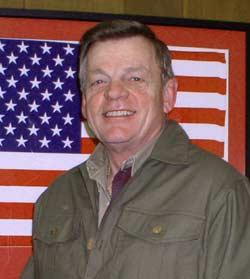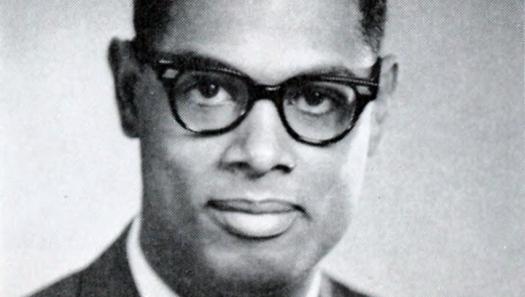WeSalute Awards
TopVet: Ken Storms, 'Piloting' Meridian, MS

For most of us, the dreams of childhood - to be a firefighter or an astronaut, a cowboy, an actress, a soldier who defeats all the bad guys - remain forever in the realm of fantasy.
Ken Storms, who "wanted to fly just about more than anything," transformed into reality the dreams of a boyhood spent in the sunny promise of Upland, California. He served 31 years in the Navy. He flew 230 combat missions in the skies over Vietnam, as an A-4E Skyhawk attack pilot and an RA5C Vigilante reconnaissance pilot, managing to avoid all a determined enemy fired at him. He served four tours of duty as a flight instructor. He was an aircraft squadron commander, air boss of an aircraft carrier, commander of Training Air Wing One, aviation safety officer for all of the Navy and Marine Corps.
As a pilot, he always had "complete and total confidence" in his abilities; and as the years went by, he knew, finally, when to hang up his wings. He is now the chief administrative officer for the city of Meridian, Mississippi.
Back in the early 1960s, when he joined up, "you could still get into aviation training from the enlisted ranks without having had to complete four years of college," he explained during a telephone conversation from his office in Meridian. If anything, he was focused and committed; he was accepted as a naval cadet after only two years of college.
After training, he was assigned to a Replacement Air Group. Which meant, he recounted, that you checked in every morning, and if someone had been shot down, the Navy flew you from your stateside squadron to a carrier at sea and you became the replacement pilot. As a replacement, Ken was flown to the USS Midway, from which he flew 38 missions in three months. All told, he would complete three combat deployments in Southeast Asia among seven extended deployments to the Western Pacific and the Mediterranean. Twenty-six of his first 36 months of marriage would be spent away from his bride.
"Life," he said, "was hectic in those days."
One in Six
Flying was rigorous work, calling for extreme competence and self-discipline. Flying into the flak of anti-aircraft batteries over North Vietnam was also dangerous. He lost friends and colleagues with whom he was, by nature and by necessity, very close. "The loss of a squadron mate was always tough to take," he said. "One of my buddies got shot down on January 13, 1967. He was on the ground a couple of days and we just couldn't get to him to get him out. He was captured.
"Two days later, another pilot from my squadron was shot down and killed. We were all angry." Disdaining prudence, his squadron executed a nighttime "alpha strike" on an enemy position. Two of the attack craft managed to get to the target area. When Ken lowered the nose of his Skyhawk and rolled in on the target, he said, reliving the moment, "all hell broke loose. Flak was everywhere. It looked like fluorescent-colored golf balls, beautiful and deadly. All of a sudden, I heard this voice telling me what the squad leader had told us: ‘Go to your gauges. Go to your gauges.' Good thing I remembered, too. I bottomed out at 500 feet before pulling up.
"And then it was totally, totally silent. I couldn't hear a thing. So I'm thinking, ‘I'm dead and this is what it's like in pilot heaven.' Then I pinched myself. I'm alive. When I checked, I found that all the communications cords had come unplugged."
Flying back to the USS Coral Sea, the XO, who had been piloting the other fighter, said he had never seen flak that heavy. Storms, though, was shaken by his experience. "I'm not putting my body and my mind through this any more," he decided. But once he landed and went to the ready room, a throng of pilots and crew was there, applauding him. He was given a bottle of brandy. All was well again in his world, if only for a little while.
"We used to talk about how one in six of us pilots would not make it back," Ken reflected. "In that squadron, four of the six didn't make it back."
SAM and Jane
On his last tour in Southeast Asia, this time piloting a recon craft, he helped give lie to a statement made by Jane Fonda, who was then visiting North Vietnam on a "peace mission."
"She said we had been bombing dikes, killing civilians, not hitting military targets," Ken said. "So my mission was to recon and photo the very dike she had claimed we'd destroyed. I was to fly over the target with a fighter escort. It was my third mission in 18 hours. The weather was awful, and we got a call to abort. But then I got a call from the admiral telling me to go in. I left my escort and went in alone. And when I pressed in on the target I saw the orange glow of surface-to-air missiles. I got the photos - evidence that there was a SAM site right on top of the dike."
After the war was finally ended, Ken was deployed to a variety of posts, none perhaps with the life-and-death imperatives of a pilot in a combat zone facing hostile fire. If there was any one lesson his three decades in the Navy taught him, it was that "necessity breeds competency: when faced with an adverse situation, you have to rise to the occasion." He also learned that part of the challenge of leadership is to ensure that talent is placed in the right place.
These lessons have served him well in his current job. "We were building this mall," he said, "and our key engineer left. Getting the right replacement was critical: he excelled."
His knowledge of pilot training also was critical in orchestrating the winning argument that kept the local naval air station from being shuttered in 1995. "We took the Navy's own numbers and showed that a plane would have to take off every two minutes" at the current PTR, or pilot training rate. This was the equivalent of the air traffic at O'Hare, Kennedy, or Newark. We made the case that taking a student naval aviator in a high-tension situation simply would not work with a single training facility. There'd be no way to catch up if you got behind."
Six of the seven commissioners in the Base Realignment and Closure commission agreed.
The citizens of Meridian and the surrounding area are grateful that Ken Storms accepted an offer from John Robert Smith, who was elected mayor in June 1993, to join his new administration as chief administrative officer. Ken, who realized that he had risen as high as he was going to in the Navy - he was a captain - decided to retire and take the post. He left with a chestful of medals: the Defense Superior Service Medal; Legion of Merit; Distinguished Flying Cross; Air Medal (19 Strike Flight and three individual), a trio of Navy Commendation Medals (with combat V); and three Navy Unit Commendation Medals, among others.
"We became a team," Ken said of his relationship with Mayor Smith. And Meridian had benefited from his competence and professionalism for the past decade.



